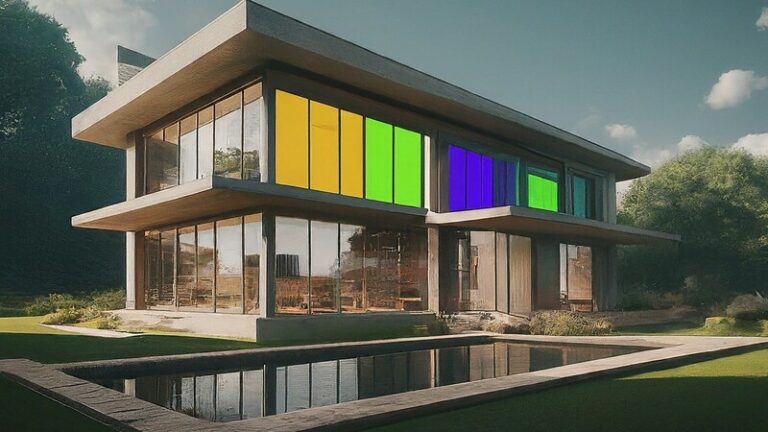Cost estimating helps stakeholders make informed decisions regarding budgeting, resource allocation, and project feasibility. It involves analyzing various factors such as materials, labor, equipment, and overheads to determine the overall expense of completing a project.
Building information modeling (BIM) is the process of developing a digital representation of the physical and functional characteristics of a building or infrastructure. It encompasses 3D models with rich data about the building’s components, materials, and spatial relationships. BIM facilitates collaboration, design visualization, analysis, and efficient project management throughout the lifecycle of a construction project.
Integrating BIM and construction cost estimation streamlines the building process, improves accuracy in estimating project costs, and enhances decision-making throughout the project lifecycle.
The Integration of Cost Estimating and Building Information Modeling
Building Information Modeling (BIM) and cost estimation are closely related within the construction industry. Here’s how they intersect:
Data Integration
BIM software allows for the creation of detailed 3D models that encompass various aspects of a building project, including its architecture, structure, MEP (mechanical, electrical, plumbing) systems, and more.
These models contain rich data about the building components, materials, quantities, and spatial relationships. This data serves as the basis for accurate cost estimation.
Quantification
BIM facilitates the quantification of building elements and materials.
By analyzing the BIM model, estimators can extract precise quantities of materials required for construction, including bricks, concrete, steel, and Heating, Ventilation, and Cooling (HVAC) components.
This quantification forms the foundation for cost estimation.
Parametric Cost Modeling
BIM software often integrates with cost estimation tools or plugins. Estimators can use parametric cost modeling techniques, where cost data is linked to BIM objects.
This allows for the automatic calculation of costs based on changes in the model. For instance, if a designer modifies the design by adding windows or changing wall materials, the cost estimation tool can dynamically update the project cost.
Visual Representation
BIM enhances the visualization of construction projects, providing stakeholders with a clearer understanding of the proposed design.
This visual representation aids in identifying potential cost drivers, such as complex architectural features or material selections, enabling more informed cost estimations.
Collaboration
BIM fosters collaboration among various project stakeholders, including architects, engineers, contractors, and estimators. Through a shared BIM model, team members can collaborate in real time, exchanging information and resolving conflicts early in the design phase.
This collaboration helps ensure that cost considerations are integrated into the design process from the outset, reducing the likelihood of costly redesigns or changes during construction. Contractor quoting software like ConWize improves communication between project stakeholders and much more.
Different BIM-Based Cost Estimating Methods
There are several BIM-based cost-estimating methods utilized in the construction industry. Some of the prominent ones include:
Quantity Takeoff (QTO)
This method involves extracting quantities of materials and components directly from the BIM model. It provides accurate measurements of items such as walls, floors, doors, windows, and MEP components, which are then used to calculate costs.
Parametric Cost Estimating
Parametric cost estimating involves associating cost data with BIM objects. By defining cost parameters based on historical data or industry standards, the software automatically calculates costs as the design changes.
This method enables rapid cost estimation based on design iterations.
Assembly-Based Estimating
In assembly-based estimating, building components are grouped into assemblies or systems (e.g., walls, floors, roofs) within the BIM model.
Each assembly is associated with predefined cost data, allowing for quick estimation of costs based on the quantities of assemblies in the model.
Cost Databases Integration
BIM software can integrate with external cost databases, such as RSMeans or local pricing databases.
Estimators can access these databases to retrieve cost data for various building components and systems, which can then be applied directly to the BIM model for accurate cost estimation.
4D and 5D BIM
4D BIM incorporates scheduling information into the BIM model, linking the construction sequence with the 3D model.
5D BIM adds cost information to this, allowing for visualization of both the construction sequence and associated costs over time. This integration enables better cost forecasting and management throughout the project lifecycle.
Each of these methods leverages the capabilities of BIM technology to improve the accuracy, efficiency, and reliability of cost estimation in construction projects.
Benefits of Cost Estimation Based on Building Information Modeling
BIM-based cost estimation offers several advantages over traditional methods:
Improved Accuracy
BIM allows for detailed 3D modeling of building components, providing precise measurements and quantities for cost estimation. This leads to more accurate cost predictions compared to manual takeoff methods.
Time Efficiency
BIM-based cost estimation automates many tasks that were previously manual, such as quantity takeoff and data entry. This saves time and reduces the effort required for estimating, enabling faster turnaround times for project budgets and proposals.
Integration with Design
BIM-based cost estimation integrates seamlessly with the design process. Changes made to the BIM model automatically update the cost estimate, ensuring that estimations reflect the most current design iterations. This facilitates early-stage cost analysis and decision-making.
Visualization
BIM models provide visual representations of the building design, allowing stakeholders to better understand the project scope and components.
Cost estimations derived from BIM can be visualized alongside the model, enhancing communication and decision-making among project teams and clients.
Collaboration
BIM fosters collaboration among various project stakeholders, including architects, engineers, contractors, and estimators.
By working on a shared BIM model, team members can collaborate in real-time, exchanging information and resolving conflicts early. This collaboration ensures that cost considerations are integrated into the design process from the outset.
Cost Control
BIM-based cost estimation enables better cost control throughout the project lifecycle. By continuously updating cost estimates as the design evolves, project teams can identify cost overruns or discrepancies early on and take proactive measures to mitigate them.
This helps ensure that the project stays within budget constraints.
Overall, BIM-based cost estimation improves accuracy, efficiency, collaboration, and cost control in construction projects, ultimately leading to better project outcomes and client satisfaction.
How Construction Estimating Software Facilitates Cost Estimating Based on Building Information Modeling
Construction estimating software plays a crucial role in facilitating cost estimating based on Building Information Modeling (BIM) by providing the following functionalities:
BIM Integration
Construction estimating software integrates with BIM platforms, allowing seamless import of BIM models. This integration enables estimators to directly access the 3D model and extract relevant data for cost estimation.
Quantity Takeoff
Estimating software automates the process of quantity takeoff by extracting quantities of materials, components, and systems directly from the BIM model. This eliminates manual measurement errors and ensures accurate quantification for cost estimation.
Parametric Cost Modeling
Estimating software incorporates parametric cost modeling capabilities, where cost data is linked to BIM objects or components.
As the BIM model evolves, the software dynamically adjusts cost estimates based on changes in quantities, specifications, or design alterations.
Cost Databases Integration
Estimating software integrates with cost databases containing pricing information for various building materials, labor rates, equipment costs, and overhead expenses.
Estimators can access these databases to retrieve up-to-date cost data and apply it directly to the BIM model for accurate cost estimation.
Visualization and Reporting
Estimating software provides visualization tools to enhance understanding and communication of cost estimates derived from BIM models.
Users can generate reports, charts, and visual representations of cost breakdowns, enabling stakeholders to make informed decisions regarding project budgeting and resource allocation.
Collaboration and Version Control
Construction estimating software facilitates collaboration among project stakeholders by enabling multiple users to access and work on the same BIM model simultaneously.
Version control features ensure that all changes to the BIM model are tracked, allowing for accurate and consistent cost estimation throughout the project lifecycle.
By leveraging these capabilities, construction estimating software enhances the efficiency, accuracy, and transparency of cost estimating processes based on Building Information Modeling.
It streamlines workflows, reduces errors, and enables better-informed decision-making, ultimately contributing to the successful delivery of construction projects within budget constraints.
Frequently Asked Questions
What Are the Methods of Cost Estimating?
Sure, here’s a concise list:
- Analogous Estimating: Relies on historical data from similar past projects.
- Parametric Estimating: Uses mathematical models to extrapolate costs based on project parameters.
- Bottom-Up Estimating: Calculates costs by estimating each component individually and aggregating them.
- Top-Down Estimating: Estimates costs based on overall project characteristics, then allocates budgets to specific components.
- Three-Point Estimating: Incorporates optimistic, pessimistic, and most likely scenarios to calculate a range of possible costs.
- Vendor Bid Analysis: Compares bids from potential vendors or subcontractors to estimate costs.
- Reserve Analysis: Allocates contingency reserves based on the level of project uncertainty.
- Expert Judgment: This relies on the expertise of experienced professionals to estimate costs.
- Cost Indexing: Adjusts historical cost data to account for inflation and market changes.
- Life Cycle Costing: Considers costs over the entire lifespan of a project or asset.
What Is the Role of Cost Estimation?
The role of cost estimation is to predict and approximate the expenses associated with a project, aiding in budgeting, resource allocation, decision-making, and project feasibility assessment.
How Is BIM Used for Cost Estimation?
BIM is used for cost estimation by providing detailed 3D models containing rich data about building components, materials, and quantities.
This data is leveraged for accurate quantity takeoff, parametric cost modeling, and integration with cost databases, enabling precise and efficient cost estimation processes.
What Is 5D Cost Estimation in BIM?
5D cost estimation in BIM refers to the integration of cost information with the traditional 3D BIM model, adding the dimension of time (4D) and cost (5D) to the project. It involves associating cost data with the 3D model elements and linking them with the project schedule.
This integration allows for the visualization and analysis of construction sequences alongside cost data, enabling better understanding, forecasting, and management of project costs throughout its lifecycle.
What Are the Three Basic Types of Cost Estimating?
- Rough Order of Magnitude (ROM) Estimate: This is an initial, high-level estimate made early in the project when limited information is available. ROM estimates are typically based on historical data or industry averages and provide a broad range of potential costs. They are used for feasibility studies, initial budgeting, and decision-making.
- Budget Estimate: A budget estimate is more refined than a ROM estimate and is developed as the project progresses and more detailed information becomes available. It involves breaking down the project into its major components or work packages and estimating costs for each. Budget estimates are used to establish project budgets, secure funding, and guide cost control efforts.
- Definitive Estimate: Definitive estimates are the most detailed and accurate type of cost estimate, developed when the project scope, design, and specifications are well-defined. They involve a thorough analysis of all project elements, including materials, labor, equipment, overheads, and contingencies. Definitive estimates are used for contract negotiations, procurement, and project execution, providing a baseline for cost control and monitoring throughout the project lifecycle.















